53
ACR – Chest – Acute Respiratory Illness in Immunocompetent Patient
Case 1
Large Bilateral Pleural Effusion
Clinical:
History: This 38 year old male was diagnosed with gallstone pancreatitis. He had severe pancreatitis. He was admitted for medical management.
Symptoms: Shortness of breath, slowly worsening over 24-48 hours. No chest pain.
Signs: Increased respiratory rate, increased work of breathing, anxious, muffled breath sounds bilaterally, percussion revealed very diminished aerated lung bilaterally.
DDx:
Bilateral Pleural effusions
Pulmonary Embolism
Pneumonia
Atelectasis
Imaging Recommendation
ACR – Chest – Acute Respiratory Illness in Immunocompetent Patient, Variant 4
Chest X-ray
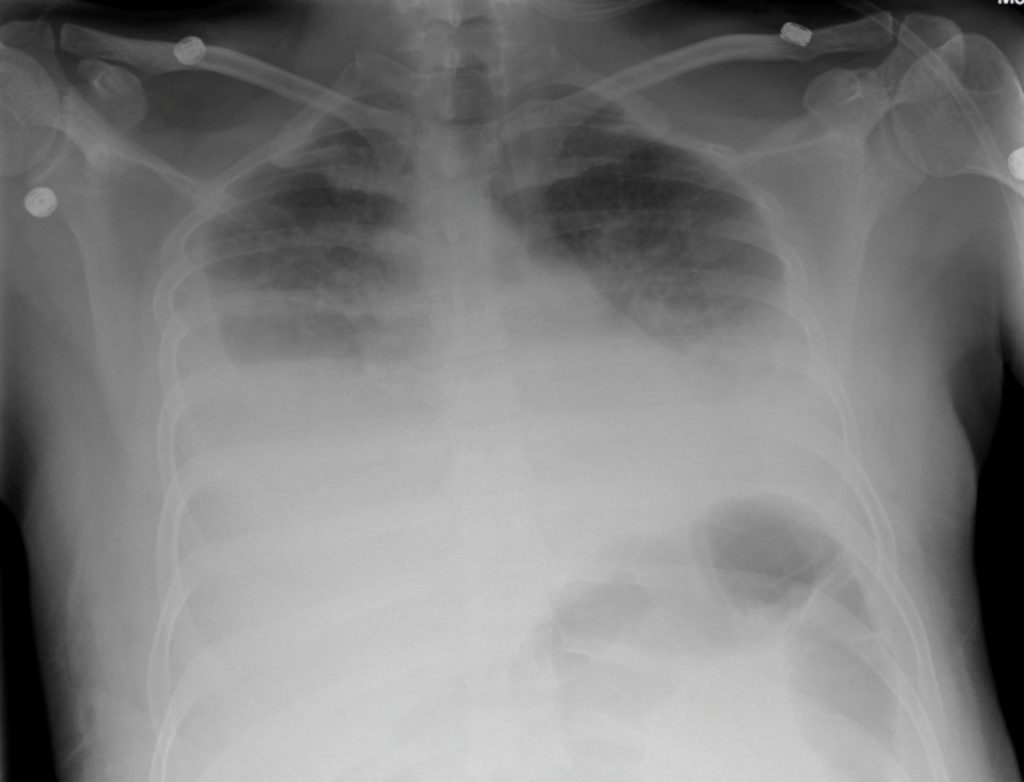
Imaging Assessment
Findings:
The lungs were poorly aerated. There were large pleural effusions present. The size of the cardiac silhouette could not be determined due to the pleural fluid. No evidence of pneumothorax.
Interpretation:
Large, bilateral pleural effusions.
Diagnosis:
Large Bilateral Pleural Effusions – X-ray and Ultrasound
Pathology:
Pleural Transudate
Discussion:
Pleural fluid may be transudate, exudate, blood, chyle, or infusate. Pleural fluid occupies space and causes the underlying lung to collapse as there is limited space in the hemithorax.
The margins of the fluid will create a meniscus with the pleura that is not seen with isolated lung consolidation.
Normally, several hundred milliliters of pleural fluid are produced and reabsorbed each day. Fluid is produced at the parietal pleura from a capillary bed and is resorbed both at the visceral pleura and by lymphatic drainage throughout the parietal pleura.
Etiology of Pleural Effusion
Fluid accumulates in the pleural space when there is an imbalance in fluid production or resorption.
Increased rate of fluid production:
- Increasing hydrostatic pressure, as in left heart failure.
- Decreasing colloid osmotic pressure, as in hypoproteinemia.
- Increasing capillary permeability, as can occur in toxic disruption of the capillary membrane in pneumonia or hypersensitivity reactions.
Decreased rate of absorption:
- Lymphangitic blockade by tumor or increased venous pressure that decreases the rate of fluid transport via the thoracic duct.
- Decreased pressure in the pleural space, as in atelectasis of the lung due to bronchial obstruction.
- Pleural effusions can also form when there is transport of peritoneal fluid from the abdominal cavity through the diaphragm or via lymphatics from a subdiaphragmatic process.
X-ray findings may include:
- Conventional radiography is usually the first step in the detection of a pleural effusion.
- The pleural fluid is opaque.
- Pleural fluid should fall with gravity and be in the most dependent part of the hemithorax, based upon patient positioning for the x-ray i.e. upright, supine, decubitus, etc. If you are suspicious of an effusion and want to see if the pleural fluid will move, it is best to do an ipsilateral side down x-ray of the chest (decubitus view).
- The fluid creates a concave meniscus in the pleural space, seen at the margins of the fluid collection.
- Fluid should be mobile and the detection of small pleural effusions can be facilitated by acquiring a same side down decubitus chest x-ray to see if the fluid moves with gravity.
Other Imaging Modalities that can Detect Pleural Effusion
- These include, Computed tomography (CT) and ultrasonography (US). CT and US are both sensitive for the detection of small amounts of pleural fluid.
- CT is the best modality for evaluating if there is an underlying abnormality causing the effusion or when the patient has complete opacification of a hemithorax that requires further assessment.
- US is especially helpful for guiding an interventional procedure to remove the pleural fluid (thoracentesis).
Case 2
Small Bilateral Pleural Effusions – Malignant
Clinical:
History: This 60 year old female was diagnosed with breast cancer 1 year prior to these x-rays. She was being followed by a Medical Oncologist. Chest x-rays were requested on the day of her clinic visit.
Symptoms: Fatigue, mild, aching, right chest pain.
Signs: Previous left mastectomy. Nil else.
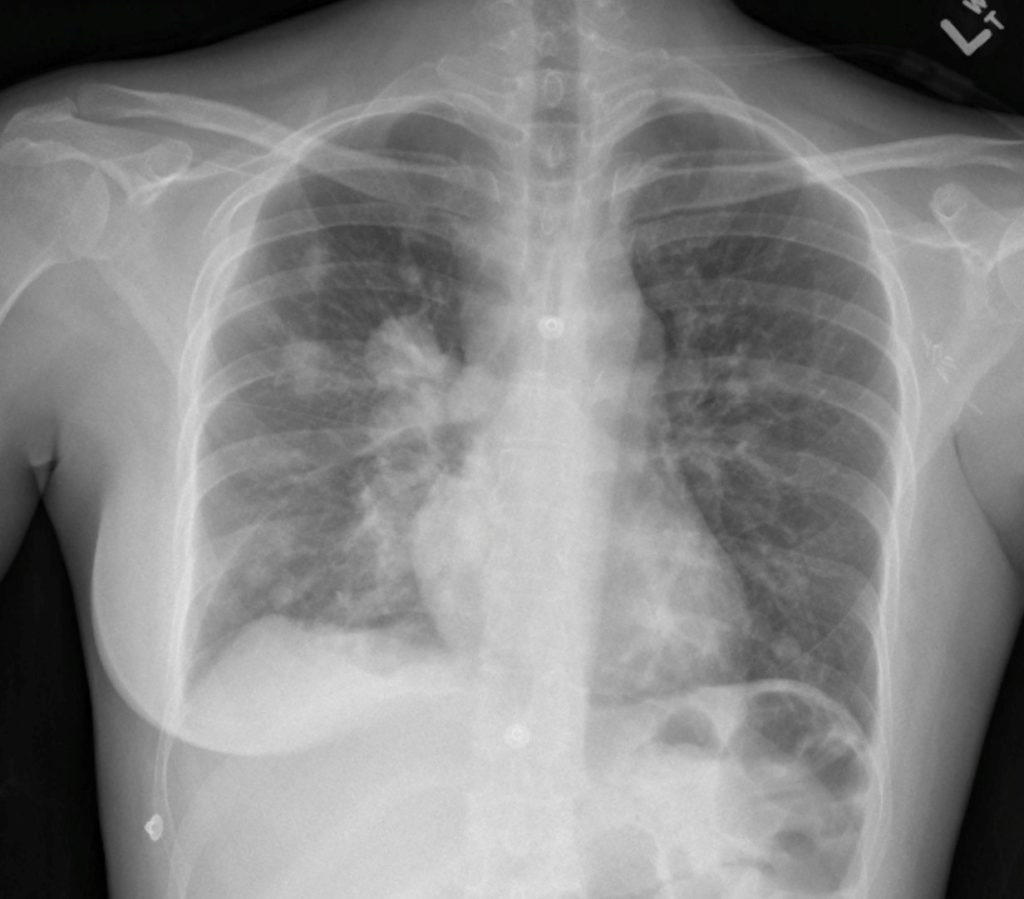
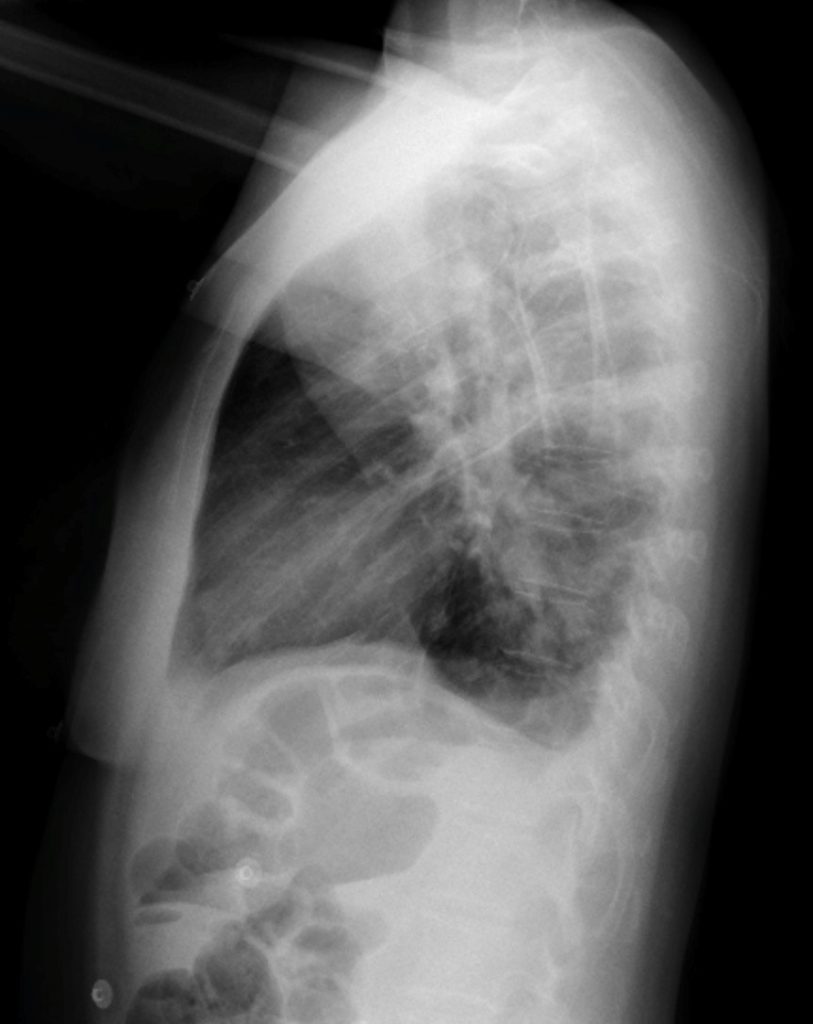
Imaging Assessment
Findings:
The patient has had a previous left mastectomy. There were nodular lesions in both lungs. The right costophrenic angle was suspected to be blunted on the frontal x-ray. There was definitely blunting of the posterior costophrenic sulci bilaterally on the lateral x-ray.
Interpretation:
Metastatic lung nodules. Small right pleural effusion.
Diagnosis:
Metastatic disease lung and pleural.
Pathology:
Malignant pleural effusion, breast cancer metastatic disease.
Case 3
Moderate Right Pleural Effusion
Clinical:
History: This 40 year old male complained of fever, cough, and right chest pain. He was admitted for medical management.
Symptoms: Shortness of breath, slowly worsening over 24-48 hours. Right chest pain, worse with deep breathing.
Signs: Increased respiratory rate, increased work of breathing, anxious, transmitted breath sounds on the right, percussion revealed very diminished aerated lung on the right. He had a fever of 40 degrees Celsius.
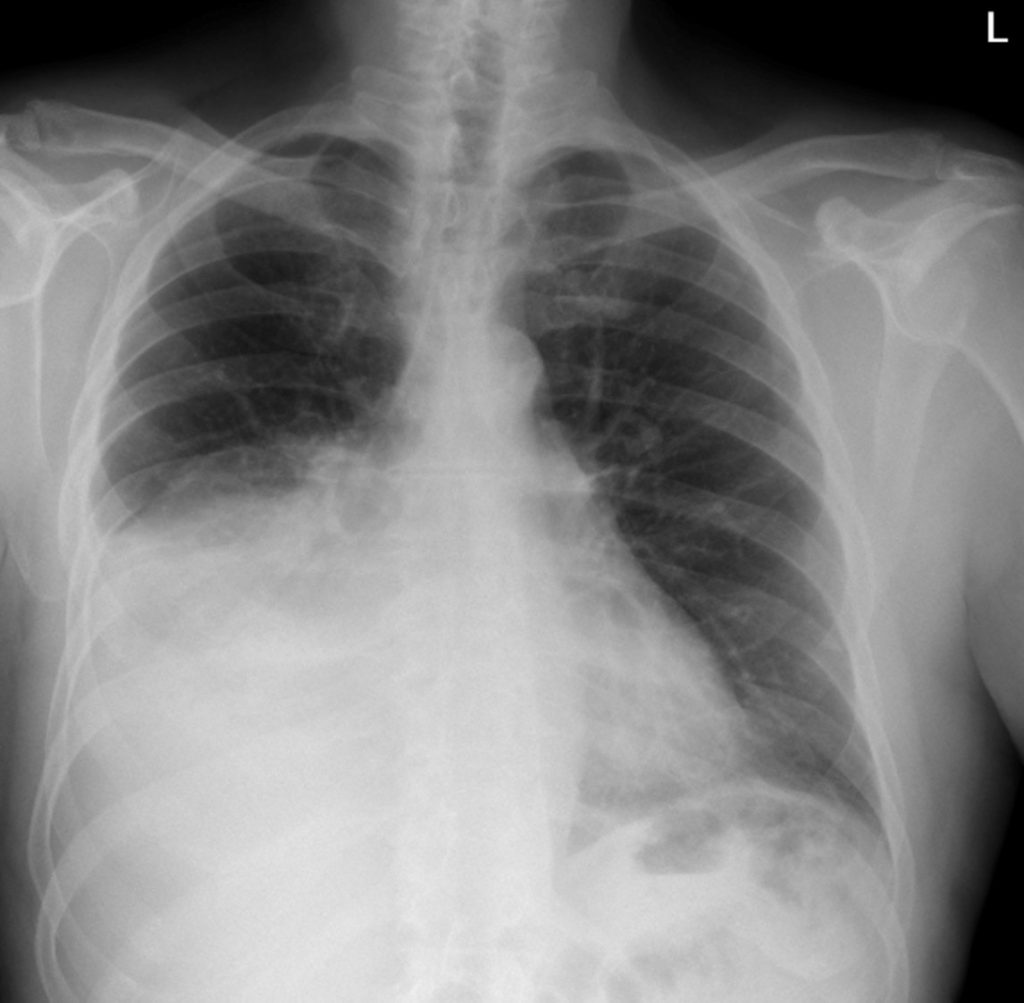
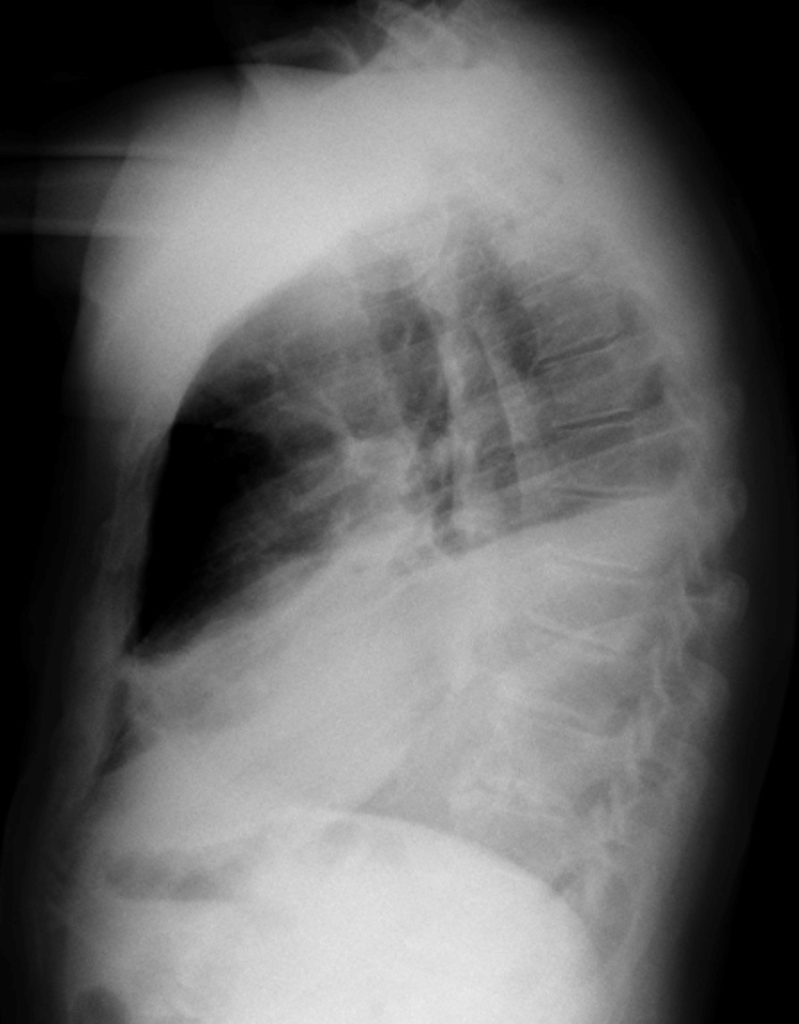
Imaging Assessment
Findings:
The right lower lobe was opaque. There were right lower lobe air bronchogram. A right pleural effusion was present.
Interpretation:
Right lower lobe consolidation with reactive right pleural effusion.
Diagnosis:
Community acquired pneumonia.
Pathology:
Pneumonia with reactive pleural effusion.
Attributions
Figure 9.14 AP Chest x-ray displaying large bilateral pleural effusions by Dr. Brent Burbridge MD, FRCPC, University Medical Imaging Consultants, College of Medicine, University of Saskatchewan is used under a CC-NC-SA license.
Figure 9.15A PA Chest x-ray displaying metastatic lung disease by Dr. Brent Burbridge MD, FRCPC, University Medical Imaging Consultants, College of Medicine, University of Saskatchewan is used under a CC-NC-SA license.
Figure 9.15B Lateral Chest x-ray displaying metastatic lung disease by Dr. Brent Burbridge MD, FRCPC, University Medical Imaging Consultants, College of Medicine, University of Saskatchewan is used under a CC-NC-SA license.
Figure 9.16A PA Chest x-ray displaying Lobar Consolidation/Collapse by Dr. Brent Burbridge MD, FRCPC, University Medical Imaging Consultants, College of Medicine, University of Saskatchewan is used under a CC-NC-SA license.
Figure 9.16B Lateral Chest x-ray displaying Lobar Consolidation/Collapse by Dr. Brent Burbridge MD, FRCPC, University Medical Imaging Consultants, College of Medicine, University of Saskatchewan is used under a CC-NC-SA license.
